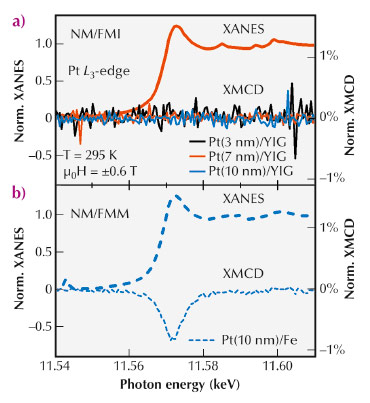- Home
- Users & Science
- Scientific Documentation
- ESRF Highlights
- ESRF Highlights 2013
- Electronic structure and magnetism
- Investigation of induced Pt magnetic polarisation in Pt/Y3Fe5O12 bilayers
Investigation of induced Pt magnetic polarisation in Pt/Y3Fe5O12 bilayers
Recently, a novel magnetoresistive effect was discovered in Pt deposited on ferrimagnetic Y3Fe5O12 (YIG) thin films, which is fundamentally different from the other magnetoresistive phenomena [1,2]. The main characteristic of this novel effect found in normal-metal/ferrimagnetic insulator (NM/FMI) bilayers is the dependence of the NM resistance on the magnetisation direction in the FMI. A possible explanation of the effect is based on static magnetic proximity effects, resulting in a finite magnetic polarisation in the NM layer as known for normal-metal/ferromagnetic metal (NM/FMM) heterostructures. In turn, this leads to ferromagnetic like transport properties in the NM thin film [2]. An alternative explanation is based on the (inverse) spin Hall effect (SHE) in the NM layer. A charge current flowing in the NM thin film is accompanied by a perpendicular spin current due to the SHE. This spin current is absorbed or reflected at the interface to the FMI depending on its magnetisation orientation. While the reflected spin current induces a charge current via the inverse SHE leaving the longitudinal resistance of the NM layer unchanged, the spin current transmitted across the NM/FMI interface represents an additional dissipation channel and thus increases the resistance [1,3].
The fundamental difference of both models is the presence or absence of an induced magnetic polarisation in the NM layer in equilibrium. Therefore, a careful investigation of this induced magnetic polarisation in NM/FMI heterostructures is essential for the correct interpretation of the reported magnetoresistance in Pt/YIG bilayers.
We investigated a series of Pt/YIG samples by XMCD at the Pt L3-edge. Taking advantage of an ultra-high vacuum cluster system, the ultrathin Pt layers with different thicknesses (3 nm, 7 nm, 10 nm) were deposited in situ by electron-beam evaporation immediately after the pulsed-laser deposition of the about 62 nm thick YIG films on (111)-oriented Y3Al5O12 substrates. For comparison, we fabricated a NM/FMM sample composed of a 10 nm thick Pt layer on a 10 nm thick Fe film.
 |
|
Fig. 106: a) Normalised XANES and XMCD spectra of normal-metal/ferromagnetic insulator (NM/FMI) samples composed of Pt layers with different thicknesses (3 nm, 7 nm, 10 nm) fabricated on YIG thin films. b) Normalised XANES and XMCD spectra of the normal-metal/ferromagnetic metal (NM/FMM) reference sample, consisting of a Pt(10 nm)/Fe(10 nm) bilayer. |
X-ray absorption near edge spectra (XANES) were recorded at the beamline ID12 around the Pt L3-edge with right and left circularly polarised light under grazing incidence as well as positive and negative magnetic fields using the total fluorescence yield (TFY) detection mode. The X-ray magnetic circular dichroism (XMCD) was calculated after averaging up to 34 single XANES per bilayer either with right and left circularly polarised light or while applying positive and negative magnetic fields. Figure 106a shows the XANES normalised to an edge jump of unity of a Pt(7 nm)/YIG bilayer and the XMCD spectra of all measured Pt/YIG bilayers around the Pt L3-edge. The XMCD signals do not show any indication of a finite induced magnetic moment in Pt down to a noise level of < 0.2%. To cross-check our experimental approach, XANES and XMCD spectra were recorded from the Pt(10 nm)/Fe(10 nm) reference sample at the Pt L3-edge (Figure 106b). Here, a clear XMCD signal is visible, demonstrating the presence of induced magnetic moments in NM/FMM heterostructures. By integrating the XMCD spectra, the total moment of Pt is calculated via the standard magneto-optical sum rules to (0.0325 ± 0.0004) µB per Pt atom in the Pt/Fe bilayer. Using the same method, an upper limit for the induced total magnetic moment of (0.003 ± 0.001) µB per Pt can be estimated in Pt/YIG bilayers. If we consider that only the first layer of the Pt thin film is polarised, then the Pt atoms at the interface would carry an induced moment, which is at least 30 times smaller than that of the Pt atoms at the interface in Pt/Fe bilayers.
In summary, taking advantage of the element-specific XMCD technique, we found that the induced magnetic polarisation of Pt in Pt/YIG bilayers is negligible and at least 30 times smaller than in the corresponding Pt/Fe reference sample. With respect to the reported novel magnetoresistive effect in Pt/YIG bilayers, our data support the model explanation based on spin currents due to the spin Hall effect [1,3] and disagree with explanations based on magnetic proximity [2].
Principal publication and authors
S. Geprägs (a), S. Meyer (a), S. Altmannshofer (a), M. Opel (a), F. Wilhelm (b), A. Rogalev (b), R. Gross (a,c) and S.T.B. Goennenwein (a), Appl. Phys. Lett. 101, 262407 (2012).
(a) Walther-Meißner-Institut, Bayerische Akademie der Wissenschaften, Garching (Germany)
(b) ESRF
(c) Physik-Department, Technische Universität München, Garching (Germany)
References
[1] H. Nakayama et al., Phys. Rev. Lett. 110, 206601 (2013).
[2] Y. M. Lu et al., Phys. Rev. Lett. 110, 147207 (2013).
[3] M. Althammer et al., Phys. Rev. B 87, 224401 (2013).



